| |
|
|
|
|
|
|
|
|
|
|
| |
| |
 |
|
| |
田润德
编译文/图 2020-05-19
20:36 |
|
| |
|
|
|
|
| |
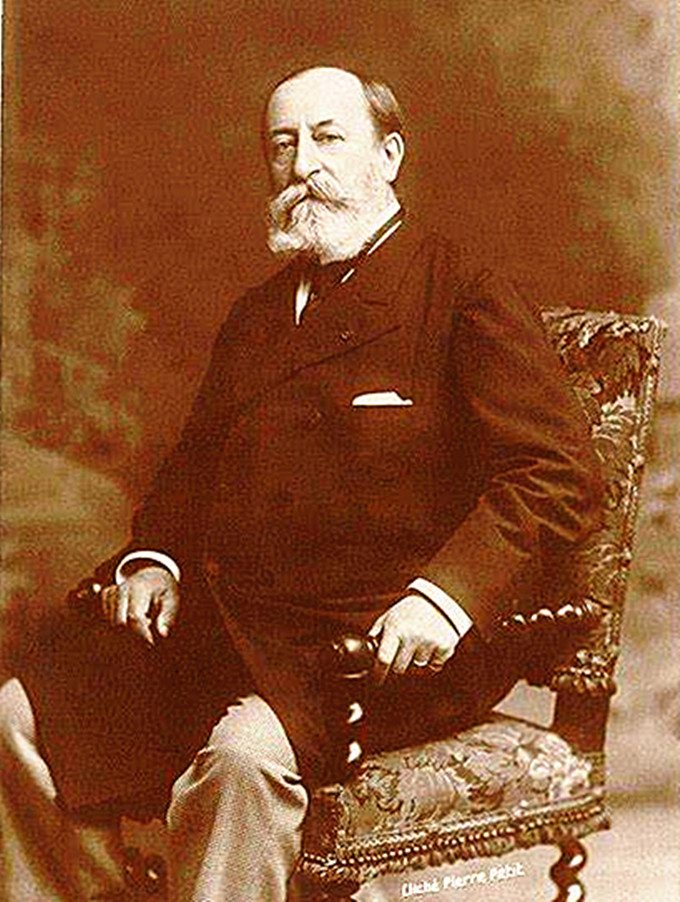 |
|
|
|
| |
夏尔·卡米尔·圣-桑(Charles Camille Saint-Saëns,1835-1921) |
|
|
|
| |
|
|
|
|
| |
田元演奏圣桑第三协奏曲第三乐章 |
|
|
|
| |
Saint-Saens, Violin Concerto No.3 in B minor, Op.61
|
|
|
|
| |
|
|
|
|
| |
音乐历史上的今天
1886年5月19日,在伦敦,圣·桑指挥了他的第三部,也时最成功的交响曲,以管风琴伴奏。由此他赢得了“法国贝多芬”的赞誉。
卡米尔·圣桑1835年10月9日出生在法国巴黎。他的父亲是法国内务部的一名普通职员,在小圣桑生下才3个月时便去世了。圣桑的成长,全靠母亲和姑妈的艰辛哺育。
圣桑的音乐才能很早就已显露,堪与莫扎特相提并论,并被称为音乐“神童”。他两7岁半开始学钢琴,3岁学乐理知识,4岁能当众演奏,5岁便写下最初的习作。这位“神童”6岁时就对大部头的作品极感兴趣,人们发现他研究莫扎特的歌剧《唐·璜》总谱,就像阅读一部动人的小说一样津津有味。
1848年,13岁的圣桑考入巴黎音乐学院学习管风琴与作曲。在校期间,这两门学业都因成绩优秀而获过奖。但他却没能获得罗马大奖,因为他当时年龄太小,只有17岁。
圣桑是一位别具特色的作曲家,他每部作品的风格都迥然不同,令人难以置信它们均出自一人之手。他才华横溢,能在与别人谈笑风生的同时飞快地作曲和配器。他的管风琴演奏享有盛誉,曾吸引过克拉拉·舒曼、萨拉萨蒂、鲁宾什坦等著名音乐家专程前往聆听。
圣桑的寿命很长,他是柏辽兹的同时代人,又亲眼看到了拉威尔的创作成就和年轻的斯特拉文斯基在巴黎享有的盛誉。圣桑在1921年12月16日即德彪西死后3年在阿尔及利亚的阿尔及尔逝世。他在20世纪虽煞经历了20多个年头,但在这段时间创作的许多作品,却没有一部经受得住时间的考验,他完全是属于19世纪法国音乐艺术的典型代表。
圣桑的学识渊博,兴趣多样,掌握多国语言,除音乐和姊妹艺术外,他还热心研究哲学、天文、考古、动物和植物等学科。因为音乐,他曾获荣誉勋位并被选入法兰西研究院。英国剑桥大学还授予他荣誉博士学位。为宣扬法国作曲家的创作和确立法国音乐生活的民族精神,他于1871年在巴黎发起组织法国民族音乐协会,亲自担任协会的第一任主席。他在1861年至1865年间曾在瑞士作曲家和音乐教育家尼德梅亚在巴黎创立的学校担任钢琴教授,福莱就是他的学生之一。他的钢琴演奏活动长达75年,直到他逝世的那一年,还亲自指挥了他的最后一次管弦乐音乐会的演出。他经常到世界各地旅行,有时对一个城市进行多次访问,他在频繁的演奏旅行中,广为传播法国音乐作品,并悉心研究包括非洲、美洲和亚洲在内的一系列国家的民间音乐创作。
圣桑的创作几乎涉及音乐的所有体裁和形式,他的作品数量众多,风格时有变易。早在40年代,他皈依当代古典和浪漫主义音乐传统,后来他显然受到柏辽兹、李斯特和瓦格纳的影响,19世纪60至80年代,即他的创作最有成果的年代,他的音乐也显得最有个性,常是热情的自由幻想同古典的完整形式、音乐的发展逻辑、纯法国式的典雅相结合。他反对宗派性的创作组织,不同意对音乐艺术的狭隘理解,因此,他没有创立自己的体系或流派。但是,圣桑的美学思想无疑对年轻一辈作曲家产生巨大的影响,他告诫年轻人不要为那种错误的倾向所诱惑。不过,圣桑本人在理论与实践问题上也有矛盾,有时为了求得形式的完整,他也会牺牲作品的内容,因此,许多作品显得缺少深度。
今日视频:1、田元演奏圣桑的《第三小提琴协奏曲》;2、杜达梅尔指挥委内瑞拉青年乐团圣-桑的《骷髅之舞》
Danse Macabre Op.40
。 |
|
|
|
| |
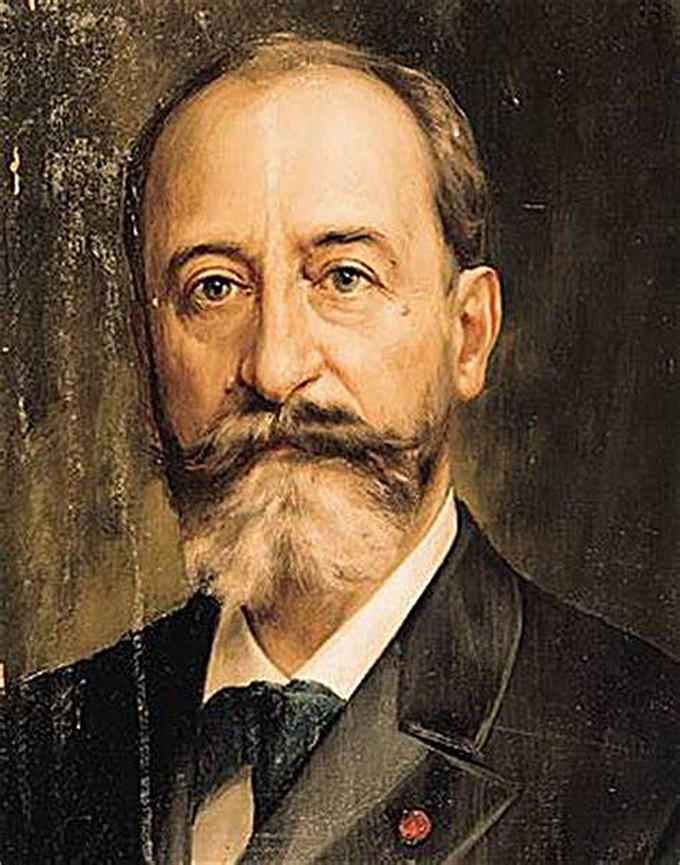 |
|
| |
40岁的夏尔·卡米尔·圣-桑(Charles Camille Saint-Saëns) |
|
|
|
| |
圣-桑多才多艺,早年曾涉猎地质学、考古学、植物学及昆虫学,他亦是一位数学专家。后来,除了作曲、演奏及撰写音乐评论外,他还与欧洲知名的科学家进行讨论,以及撰写关于声学、巫术科学、罗马剧院装修及古老乐器的学术文章。他曾编写一份哲学著作,名为Problèmes
et
Mystères,讲述科学及艺术会取代宗教;圣-桑悲观及无神的理念,预示了存在主义的出现。他的其他学术成就还包括一册名为Rimes
familières的诗集,及一份十分成功的滑稽剧本,名为La Crampe des
écrivains。圣-桑亦是法国天文学会的成员;他还教导海市蜃楼,又懂得按自己的要求制作望远镜,以及按如日食般的天文现象来计划演奏会。
1870年,圣-桑参与了国家防卫军,并参加了普法战争。短短半年的战争,令圣-桑心中留了下了一道永不磨灭的疤痕。1871年,圣-桑与Romain
Bussine成立国家音乐社团组织,借此推广新的法国音乐。巴黎公社瓦解后,圣-桑以社团组织主席身分,公开首演社团成员的作品,包括福莱、塞扎尔·弗兰克、拉罗及他本人的作品,令他成为塑造法国音乐将来的重要人物。
1875年,圣-桑与Marie-Laure
Truffot结婚并育有两名孩子,但不幸于1878年先后逝世。三年后圣-桑离开了妻子,然二人并无正式离婚。据说圣-桑后来牵涉入同性恋的关系中,由于他曾于公开场合备受指责,他竟以自己有娈童恋性倾向为反驳。(法:Je
ne suis pas homosexuel, je suis pédéraste!;中译:我不是同性恋者,我是娈童恋者! |
|
|
|
| |
Saint sang
was a versatile man who had dabbling in geology, archaeology, botany and
entomology in his early years. He was also an expert in
mathematics.Later, in addition to composing, performing, and writing
music reviews, he discussed with prominent European scientists and wrote
scholarly articles on acoustics, the science of witchcraft, the
decoration of Roman theaters, and ancient Musical Instruments.He wrote a
philosophical treatise, Mysteres et Mysteres, about science and art
replacing religion;Sheng-san's pessimistic and godless ideas foreshadoed
the emergence of existentialism.Other scholarly achievements include a
volume of poetry called Rimes familieres, and a highly successful comic
play called La Crampe des ecrivains.Saint-sant is also a member of the
French astronomical society;He taught mirages, made his own telescopes,
and planned concerts for astronomical events such as solar eclipses.
In 1870, saint sang joined the national defense army and took part in
the franco-prussian war.Short half a year of war, so that saint - sang
heart left an indelible scar.In 1871, saint - sang and Romain Bussine
established the national music society to promote new French music.After
the collapse of the Paris commune, saint-sang, as President of the
society, premiered the works of its members, including those of Foley,
cezal frank, rallo and himself, making him an important figure in
shaping the future of French music.
He married marie-laure Truffot in 1875 and had two children, but died in
1878.Three years later saint - SAN left his wife, although the two did
not formally divorce.He is said to have later been involved in
homosexual relations, and because he had been publicly accused, he
argued that he was a homosexual.(method: Je ne suis pas homosexuel, Je
suis pederaste!;I am not a homosexual, I am a child molester! |
|
|
|
| |
|
|
|
|
| |
Today in the
history of music
On May 19, 1886, in London, saint sang conducted his third and most
successful symphony to the accompaniment of the organ.Thus he won the
praise of "French Beethoven".
Camille saint-sant was born on October 9, 1835, in Paris, France.His
father, a clerk in the French interior ministry, died just three months
after the baby was born.The growth of saint mulberry, all depend on the
mother and aunt of hard feeding.
Saint - sang's musical talent has long been apparent, comparable to
Mozart, and known as the music "child prodigy."He began to learn piano
at the age of two and seven and a half, studied music theory at three,
played in public at four, and wrote his first composition at five.By the
time he was six, the prodigy had become so interested in tomes that he
was found to enjoy studying the score of Mozart's don Juan as much as
reading a moving novel.
In 1848, at the age of 13, he entered the Paris conservatory of music to
study organ and composition.At school, both subjects received awards for
outstanding academic performance.But he didn't win the Rome prize
because he was too young, just 17 years old.
Saint - sang was a distinctive composer, each one of his works in a very
different style, it is incredible that they were all written by one
person.He was a brilliant composer and orchestrator who could laugh and
talk with others at the same time.His organ performance enjoyed a high
reputation, which attracted famous musicians such as Clara schumann,
sarasati and rubenstein.
Saint-sant lived a long life, was a contemporary of Berlioz, and saw
with his own eyes ravel's work and the reputation of the young
stravinsky in Paris.Saint sang died in Algiers, Algeria, on December 16,
1921, three years after Debussy's death.Although he lived through more
than 20 years in the 20th century, none of his works could stand the
test of time. He is a typical representative of French musical art in
the 19th century.
He was a man of many languages, and in addition to music and sister
arts, he was also interested in the study of philosophy, astronomy,
archaeology, animals and plants.For his music, he was made an honorary
order and elected to the French academy.The university of Cambridge also
awarded him an honorary doctorate.In order to promote the creation of
French composers and establish the national spirit of French musical
life, he initiated and organized the French national music association
in Paris in 1871, and served as the first President of the association
himself.He was a piano professor at the school founded in Paris by Swiss
composer and music educator niedermeyer from 1861 to 1865, among his
students.He played the piano for 75 years and conducted his last
orchestral concert until the year of his death.He traveled frequently
around the world, sometimes to one city for many visits. During his
frequent travels, he spread French music widely and studied the folk
music creation of a series of countries, including Africa, America and
Asia.
Saint sang's creation involves almost all genres and forms of music, and
his works are numerous and vary in style from time to time.In the early
'40 s, he converted to contemporary classical and romantic music
tradition, he apparently influenced by Berlioz, liszt, and Wagner, 19th
century 60 s to 80 s, namely his creative s most achievements, his music
is the most individuality, is often the free fantasy of enthusiasm with
the classical full form, the development logic of music, combination of
pure French elegance.He opposed sectarian creative organizations and a
narrow understanding of the art of music, so he did not create his own
system or genre.But saint-sausant's aesthetic ideas undoubtedly had a
great influence on the younger generation of composers, who he warned
against being seduced by erroneous tendencies.However, saint sang
himself had contradictions between theory and practice, and sometimes he
would sacrifice the content of his works in order to obtain the
completeness of the form. Therefore, many of his works appeared to lack
depth.
Today's video: 1. Tian Yan plays the third violin concerto by sheng
sang; 2.2. Dudamel conducts Danse Macabre op.40, "the dance of the
skull" by the Venezuelan youth orchestra saint-sang. |
|
|
|
| |
|
|
|
|
| |
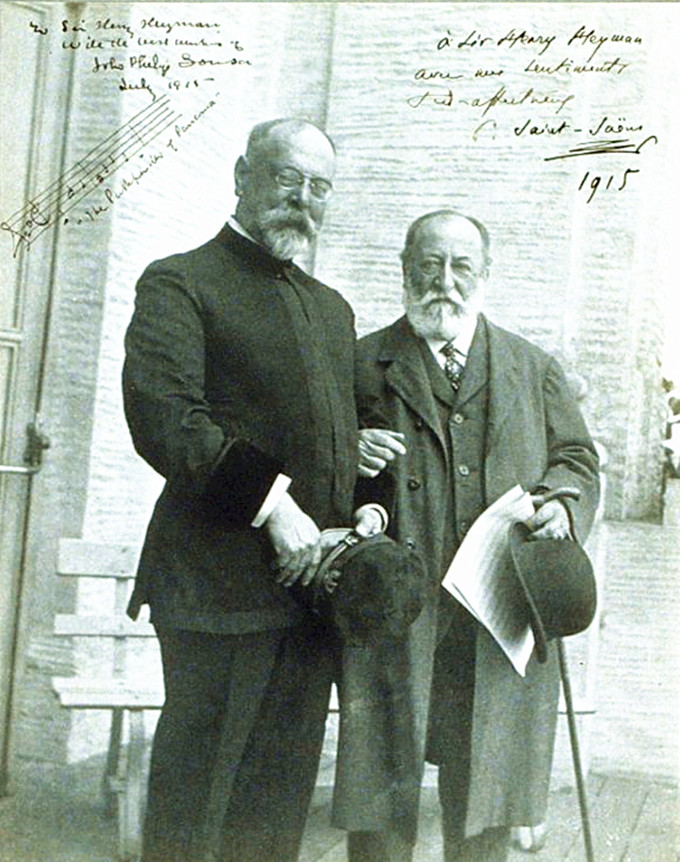 |
|
| |
巴拿马太平洋国际博览会上的约翰·菲利普·苏萨和查尔斯·卡米尔·圣-萨恩斯 |
|
|
|
| |
John Philip Sousa and
Charles-Camille Saint-Saëns at the Panama-Pacific International
Exposition |
|
|
|
| |
|
|
| |
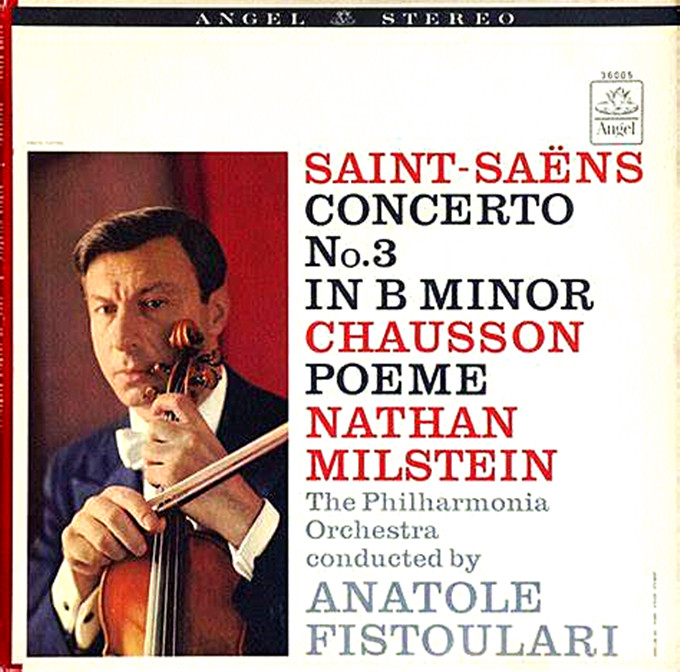 |
|
| |
|
米尔斯坦演奏圣·桑第三小提琴协奏曲的CD唱片封面。 |
|
|
|
|
| |
圣·桑:B小调第三小提协奏曲介绍: |
|
|
|
| |
圣·桑:B小调第三小提协奏曲作品61号 :
《Saint-Snens:Concerto for and Orchestra No.3,in B
Minor,1880)
圣·桑的三部小提琴协奏曲中,这第三部是最受欢迎和被演奏得最多的一部。提琴家们喜爱它,因为它不仅具有优美的旋律和迷人的诗意多、而且为小提琴表现各种技巧提供了广泛的机会。这些优点恐怕也同样符合音乐爱好者的要求。就名气而言,这部B小调协奏曲的地位和其他两首小提琴协奏曲地位相比,就像圣·桑的第二钢琴协奏曲和其他四部钢琴协奏曲一样,远远地胜过它们。沃森·莱尔(WatSn,n
Lyle)在著作的书中认为圣·桑的B小调协奏曲是“永存”的,这也包括圣·桑其他小提琴和乐队作晶中的《引子与回旋随想曲》《Introduction
and Rondo Capricciso Op.28,1863);《哈瓦奈斯》(Havanaise
OP.83)和《安达卢斯随想曲》(Caprice
Andalous,OP.122),此外,在圣·桑完成其第三小提琴协奏曲后不久,1880年他还写了《音乐会小品》(Morceau
de Concert,OP.62),也属此例。
1881年1月2固在巴黎夏特莱(Chatelet)音乐会上演奏和介绍了此作品,由著名的小提琴家萨拉萨蒂担任独奏。萨拉萨蒂在2月20日举行该作品第二次演出的音乐会上仍担任了独奏,同场演出的还有他的西班牙舞曲和在法国首次公演的勃鲁赫《苏格兰幻想曲》(Brueh:Scottish
Fantasy)。该协奏曲第二年出版,是专为献给这位伟大的西班牙提琴大师的。
圣·桑的这首提琴协奏曲为他的学生们显示了高度的富于想像力的写作手法,影响较大。奥托。奈泽尔(Otto
Neitzel)在他的自传中谈到它第一和第三乐章的特点是;
“忧郁的决心”,它最后掀起了“强烈的热情”。慢乐章中笼罩着“春天阳光的微笑”。最后是“一首赞美诗,它作为是热情奔放后;平静而满足的插曲”。
对那位英国人莱尔来说,这“稍快的行版”(第二乐章)当然就是威尼斯的船歌(Barcarolle),好似“有回声的歌声飘荡在静静的潮面上,小舟载送着青年们,懒洋浮
地驶向西下的夕阳。”莱尔觉得这乐章“在快乐中有心事”那用泛音演奏的十三小节分奏和弦呈现了一幅清晰的画景:“
当小舟越漂越远时,声音也就逐渐消逝。”
莱尔继续分析说:
“第三乐章充满刚强有力的气氛,富于生命力,具有南方晴天的温暖。独奏乐器以热烈的姿态闯入,就像一团窒息浓烟的火苗,只要有丝毫加温,随时会发展成猛烈的火焰。
不久我们就得道一个动机,它交错着固执和甜言密语,并不摈弃生活的快乐。然后是胜利,这胜利浸沉在相互热恋狂喜中,不管生活将怎样继续,胜利它将以傲慢、冷漠的姿态冲往直前,因为它坚信已寻到了爱”。
曲按传统习惯为独奏提琴配备两支长笛(其中,一支后转高音笛)箩两支双簧管,两支单簧管,两支大管,两只圆号两只小号、三只长号,还有铜鼓和弦乐。
始的乐章有二个强烈对比的主题形式。第一个主题由独奏提琴表达,热情有劲,带有精力旺盛的挑战性质。第二主题转为B大调,是以比较平静的姿态出现。法国的传记作家乔治。塞尔维埃(Geoges
Serveres)觉得它是“圣·桑笔下最具有柔和旋律的灵感之一”。塞尔维埃在圣·桑家里第一次听到萨拉萨蒂演奏此首协奏曲时,特别为这位西班牙提琴家处理这两个相对的主题有这样显著变化而受到震动。
在“稍快的行版”,
(降B大调6/8)中,独奏提琴家哼起了懒散而优美的船歌,每句短句最后总有其他乐器接上。双簧管重复了主题。这乐章有西西里安诺舞曲的特点。最后一个乐章(颇中庸和庄严,B小调,4/4》由小提琴的朗诵开始,然后乐队伴奏加入。独奏旋律在大管和园号的支持下长驱跨入活泼的“快板”。第二主题,似歌般地,由提琴奏出。第三主题,很唐突地,也由提琴担任,但转为D大调,过后,带有宗教般宁静的第四主题(G大调)由弦乐(小提琴和中提琴)加上弱音器表现出来,在它持续安静的气氛中,主题显示了瓦格纳《罗恩格林》(Lohengrin)d的“前奏”,在结尾前有一个以第三主题为主,经过精心加工的发展部。 |
|
|
|
| |
Concerto
no. 61 in B minor no. 3:
"Saint-snens :Concerto for and Orchestra No.3,in B
Minor,1880)
Of the three violin concertos by saint sang, this
third is the most popular and played.Violinists love
it because it not only has beautiful melody and
charming poetry, but also provides a wide range of
opportunities for violin performance.These virtues
may also appeal to music lovers.As far as fame is
concerned, this concerto in B minor is far superior
to the other two violin concertos, just as saint
sang's piano concerto no. 2 and the other four piano
concertos are.WatSn, n Lyle wrote that the concerto
in B minor was "forever", including Introduction and
Rondo Capricciso op. 28,1863, "Havanaise op. 83" and
"Caprice Andalous" (op. 122), among other
things,"Morceau DE Concert (op. 62), which he wrote
in 1880, shortly after he finished his third violin
concerto, is another example.
On January 2, 1881, the work was performed and
introduced at a concert in Chatelet, Paris, with the
famous violinist sarasati as a soloist.Mr. Sarasati
also played a solo at a concert on Feb. 20, the
second performance of the piece, along with his
Spanish dance music and Brueh's "Brueh: Scottish
Fantasy," which premiered in France.The concerto,
published the following year, was dedicated to the
great Spanish violin master.
This violin concerto by saint sang shows a high
degree of imaginative writing for his students,
which has a great influence.Otto.In his
autobiography, Otto Neitzel talks about the features
of the first and third movements;"The melancholy
resolution," which eventually inspired a "strong
passion."The slow movement is covered with "the
smile of spring sunshine".And finally, "a hymn,
which ACTS as a passionate after;A calm and
contented interlude.
To the Englishman lyell, this "swifter version" (the
second movement) was, of course, the Barcarolle of
Venice, as if "an echo of song floated on the still
tide, and boats carried the young, and the lazy
ocean floated
To the west into the sunset."Lyell felt that this
movement, "in the joy of the heart," presented a
clear picture of the 13 bars of segmented chords
played in overtones: "as the boat drifted farther
and farther, the sound gradually died away."
Lyell went on to say:
"The third movement is full of strong and energetic
atmosphere, full of vitality and warmth of sunny
days in the south.The solo instruments burst in with
a passion, like a smothering flame, which, with the
slightest warmth, grows into a violent flame.
We soon acquire a motive, mingled with obstinacy and
sweetness, that does not reject the pleasures of
life.Then comes victory, in the ecstasy of mutual
love, which, however life goes on, carries on with
haughty indifference, because it is sure that it has
found love.
It is traditional to have two flutes (one of which
goes to the treble), two oboe, two clarinet, two
bassoon, two horns, two trumpets, three trombones,
and drums and strings for the solo violin.
The first movement has two contrasting thematic
forms.The first theme is expressed by the solo
violin, which is passionate and challenging.The
second theme is in B major, which is in a relatively
calm attitude.George, French biographerTo the Geoges
Serveres, it was "one of the most gentle melodic
inspirations of saint-saens".Sylvie Emmanuel in
Lhasa saint mulberry home the first time I heard she
played this concerto, in particular for the Spanish
violin family deal with the two relative theme has
such a significant change and trembled.
In "a little faster" (6/8 in B flat major), the solo
violinist hums a lazy, graceful barcarolle, each
phrase ending with another instrument.The oboe
repeated the theme.This movement has the hallmarks
of a Sicilian ano.The last movement (rather neutral
and solemn, 4/4 in B minor) begins with a violin
recital, followed by the orchestra.The solo melody,
supported by the bassoon and the garden horn, moves
into the lively allegro.The second theme, like a
song, is played by a violin.Third theme, very
abruptly, also shall be a bass, but turned in D
major, later, as peaceful fourth religious theme (G
major) by the string (violin and viola) plus a mute,
in its quiet atmosphere and theme shows the Wagner,
"RON green" (Lohengrin) D "prelude", before the end
of one in the third theme is given priority to,
carefully processing development. |
|
|
|
| |
|
|
|
|
| |
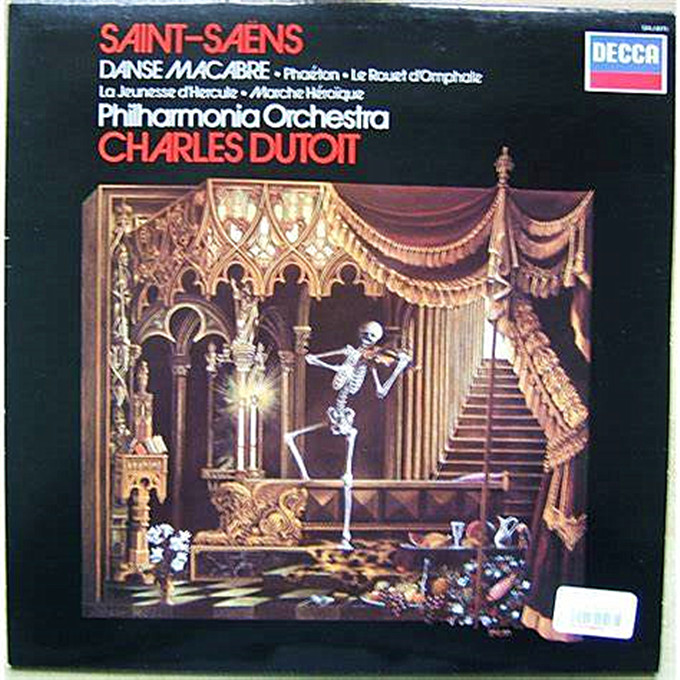 |
|
|
|
| |
克交响诗《骷髅之舞》(Christopher Hogwood) |
|
|
|
| |
交响诗《骷髅之舞》;0P。40
死神是中世纪和文艺复兴时期欧洲艺术家们的常用主题。《死神之舞》创作于1874年,翌年初演后便使作者的声名传遍全欧。《死神之舞》是圣桑的流行最广的作品之一。圣桑的《死神之舞》(又称《骷髅之舞》),并非从德国画家荷尔本的木版画作《死神之舞》中取材,而是依据法国诗人卡扎里斯的同名幻想诗作写成。圣桑原先把这个题材写成一首歌曲,但因它的旋律有点难唱,又把它改为管弦乐曲。
“吱咯,吱咯,吱咯,死神合着节奏,
用踝骨在墓石上敲打拍子;
他在午夜拉小提琴,
吱咯,吱咯,吱咯,奏出一首舞曲。
寒风呼啸,夜色苍茫,
椴树下传出声声呻吟;
暗处闪忽着骷髅的白色身影,
他们裹着宽大的寿衣飞奔乱跳。
吱咯,吱咯,吱咯,个个跳跳蹦蹦,
舞者的白骨格格作响。
可是,别作声,公鸡已经报晓,
他们突然停止跳舞,慌慌张张,东逃西窜。”
这是一则古老的神话所叙述的万圣节之夜,据说每年11月1日,所有的鬼魂在午夜里都聚在一起狂歌乱舞。乐曲开始时,竖琴在弦乐器持续和弦的陪伴下,准确地拨出]2个附点二分音符,宣告“鬼魔的时辰”已经到来,墓地的石门随即大开,众鬼魂都从自己的墓穴里爬出来,为首的一个拿着一把小提琴,这就是死神。现在,他正在调试他的乐器——按作者的要求,乐队的独奏小提琴的弦调比较特别,它的第四根弦调低半音,同第三根琴弦构成一个减五度音程,因此给人一种古怪的感觉。接着诸鬼魂的群舞便开始了。
这是乐曲的第一主题,主要是急骤的八分音符音型,全是断音,作者标明是一支圆舞曲,但它的节奏却刻板、鲁莽,加上长笛独奏,使音乐更加显得阴森和惨淡。乐曲的这一主题改由小提琴声部复奏后,独奏小提琴立即奏出乐曲的另一主题。这两个主题以各种不同的戏剧性笔法幂口巧妙的技巧进行无数次的变奏反复,其中当木琴加入演奏旋律时,好像有意模仿骷髅跳舞时用脚踝骨击墓石的声响,从而更逼真地再现了中世纪古木琴的死神形象。
这段音乐有时借第二主题本身的赋格式进行来发展,有时用半音阶乐句的穿插以强调阴风呼啸和鬼魂悲鸣,甚至也可以想像为幽灵的狞笑,到乐曲的最高潮,则是第一和第二主题的有机结合:舞蹈的旋风越刮越猛,力度越来越强,气焰越来越嚣张。但是,狂乱的舞蹈突然中止,法国号的和弦暗示了黎明的微曦,双簧管立即模仿雄鸡的啼叫,象征诸鬼魂竞相逃入各自墓穴的神秘和弦渐次减弱并消失,只有死神的小提琴还在勉强发出几声有气无力的哀鸣,但随即也在神秘的簌簌声中隐去. |
|
|
|
| |
|
|
| |
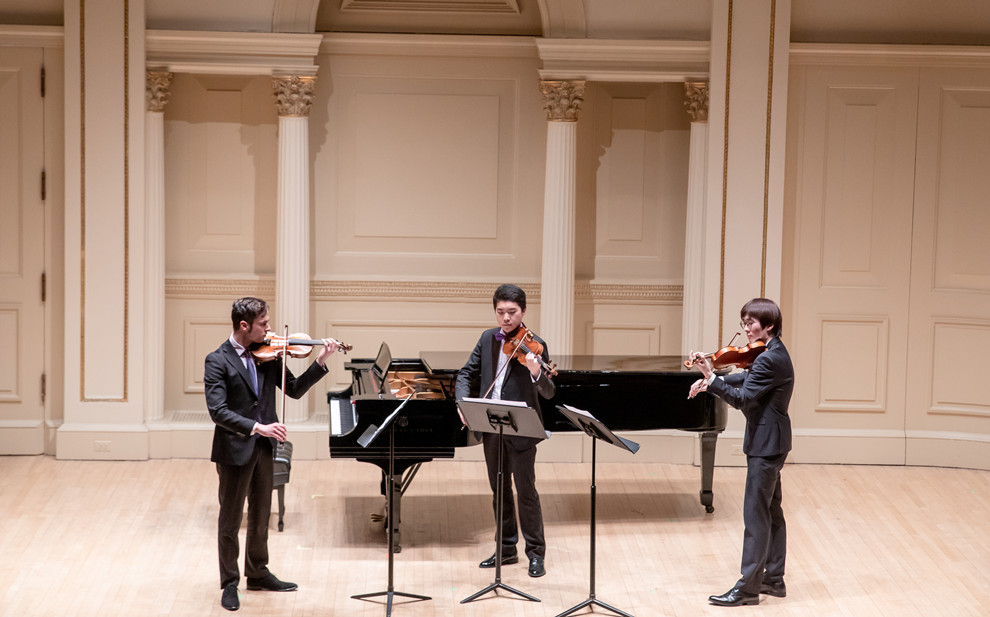 |
|
| |
2019年4月,田元在美国新泽西州参加了国际青年人才表演视觉艺术节,并获得了小提琴青年组的第一名。艺术节奖励田元和其它获奖人员在2019年12月26日在卡内基演奏舒伯特的三重奏。 |
|
|
|
| |
In
April 2019, tian participated in the international youth talent
performance and visual arts festival in New Jersey, the United
States, and won the first prize in the youth violin group.Artist
award tian yuan and other laureates perform schubert's trio at
Carnegie Hall on Dec. 26, 2019. |
|
|
|
| |
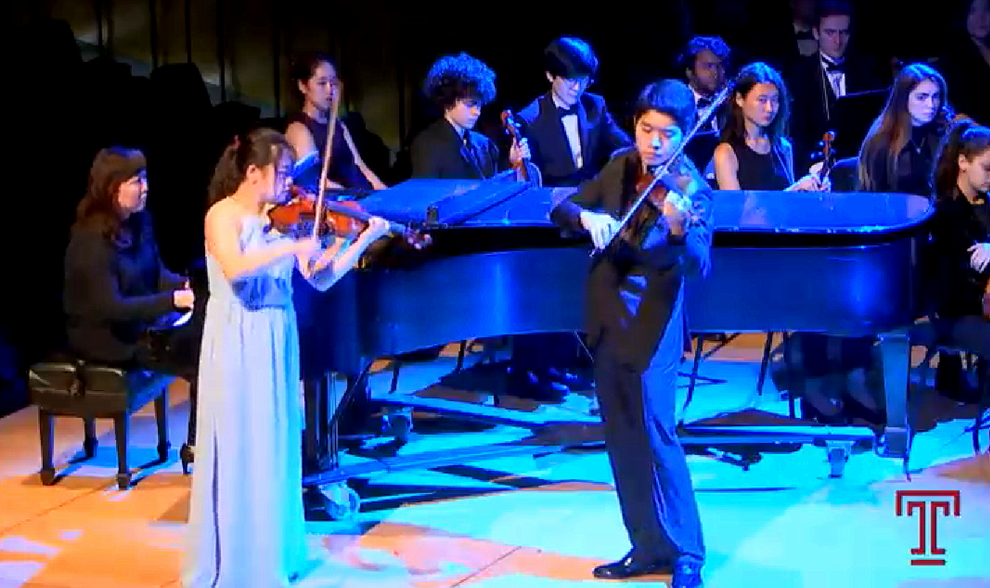 |
|
| |
田元和师姐姚璇在天普大学的音乐会上演奏萨拉萨蒂的纳瓦拉小提琴二重奏。 |
|
|
|
| |
Tian
yuan and her senior sister yao xuan played sarasati's navarre
violin duet at the temple university concert. |
|
|
|
| |
田元1999年生于哈尔滨,3岁半随父田润德学琴,四岁登台表演。2009年考入中央音乐学院附小四年级师从汤伟剑副教授。2014年参加勋菲尔德国际弦乐比赛,获得少年组优秀表演奖;2015年获得中央音乐学院奖学金竞赛三等奖;2016年获得香港艺术节小提琴青年组二等奖。2017年赢得了参加NYO-china中美巡演,以全额奖学金被天普大学博伊尔音乐学院录取,师从著名小提琴大师爱德华·施密德先生。2019年又赢得与NYO-china欧洲巡演。2019年荣获美国青年才艺表演艺术节一等奖,并赢得2020年2月26日在卡内基的演出资格。 |
|
|
|
| |
Tian Yan was born in
Harbin in 1999. He learned to play the piano at the age of three
and a half, following his father tian runde.In 2009, I was
admitted to the central conservatory of music.In 2014, I
participated in the schoenfeld international string competition
and won the outstanding performance award of the junior group.In
2015, won the third prize in the central conservatory of music
scholarship competition;In 2016, she won the second prize in the
violin youth group of Hong Kong arts festival.In 2017, he won
the nyo-china sino-us tour and was admitted to the Boyle
conservatory of music of temple university on a full
scholarship, under the tutelage of the famous violin master Mr.
Edward schmid.In 2019, it won the European tour with
nyo-china.In 2019, he won the first prize of the young talent
show and art festival of the United States, and won the
qualification to perform at Carnegie on February 26, 2020. |
|
|
|
| |
|
|
|
|
| |
|
|
|
|
| |
【圣-桑】骷髅之舞 Danse Macabre Op.40
|
|
|
|
| |
卡尔·夏米尔·圣-桑 骷髅之舞 Danse Macabre Op.40
委内瑞拉青年乐团 杜达梅尔指挥 |
|
|
|
| |
Danse
Macabre op.40 conductor of Venezuelan youth
orchestra dudamel |
|
|
|
| |
|
|
|
|
| |
未得原作者编者授权严禁转载www.mt77.com任何内容 |
|
|
|
|
|
|
|
|
|
|
|
|
|
|


